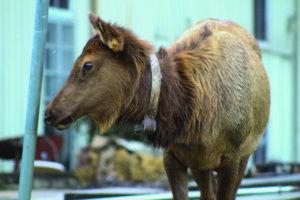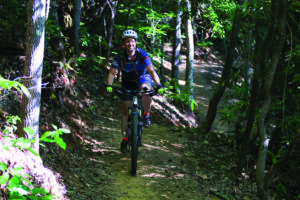By ROBERT JUMPER
ONE FEATHER EDITOR
It is easy to take the place you live for granted. I have lived in the mountains of western North Carolina most of my life. As a good friend and former coworker used to say, I have fished these streams and walked these trails all my life.
When I was a young man, it was my greatest to desire to leave the mountains and live in the big city, where there was excitement and “things to do”. I was not alone in my thinking, and even today, when locals get a break, say “Spring Break”, they head for the beaches.

BEAUTY: This elk, part of a herd of about 12, was seen in front of the Steve Youngdeer American Legion Post 143 headquarters in the Yellowhill Community on the afternoon of Thursday, Feb. 25, 2016. (SCOTT MCKIE B.P./One Feather photos)
Yes, the mountains are beautiful, but for some and like many things, when we get so familiar with them, they lose their luster and we long for something different. For example, I like broccoli. Give me broccoli for a single meal and I am a more than happy camper. But, if you serve me broccoli for every meal of the day for a month, I am going to be sick of broccoli and will be looking for something else to satisfy my appetite. We see the mountains every day of our lives and ride away from them when the opportunity arises. Folks in the city and at the beaches gravitate toward the mountains and for similar reasons.
It is a good thing that people do seek something different from time to time. The Tribe has sustained itself with those looking for a change of pace and scenery for many decades now. When logging died out as a viable support income for the Cherokee people in North Carolina (aside from federal assistance), we turned to family tourism as our source of income for several decades. And today, we still court the families looking for a cultural, outdoor adventure, even though our adult gaming tourists have been more prolific.
A growing elk population has helped to revitalize an aging family tourism product in Cherokee. When the U.S. Forest Service and the Rocky Mountain Elk Foundation collaborated to bring elk back to the North Carolina mountains, an unexpected consequence was that the roaming of elk would include regular visits from the herds to the Qualla Boundary, particularly areas near heavily-traveled roadways.
The sight of these majestic animals in what was once their native home is without a doubt one of the larger family attractions for Cherokee in some time. Folks will stop their cars in the middle of the road to take in the usually very docile and lumbering giants. Some take the more dangerous and extreme measure of getting out of their vehicles and approaching the elk to get a selfie. A bull elk can tip the scales at a whopping 730 lbs. The females usually weigh just over 500 lbs. Like any animal in the wild, an elk runs when it gets scared and, because of its size, it doesn’t necessarily have a plan for a direction to run. So, if you or your vehicle happens to be in its path, you are going to have a lot of explaining to do with your insurance adjuster.
From a distance, the elk are some of the most fascinating animals in the world to watch, as well as some of the most beautiful. Many of you have posted pictures and video of the elk on the Boundary that are breathtaking. Of course, the elk are a mixed blessing because they tend to eat food where they find it, and sometimes that is in our tribal farmers’ gardens. The Tribe continues to find ways to balance our desire to see these great creatures, control their access to private properties, and protect the public.

FISHING: Participants line the Oconaluftee River at a previous Talking Trees Children’s Trout Derby.
The Oconaluftee River is our most attractive natural asset on the Boundary. It is our primary community water source, supplying hundreds of homes and businesses with water for many years. It has been the water source of the Cherokee people in this area since recorded time. The historic significance of our river and its feeding creeks and streams is beyond definition. Ancient Cherokee ancestors drank, cooked, and cleaned from the waters of the Oconaluftee. There is a mystical element to our water, many using it to spiritually purify themselves.
This river, among others in WNC, saw Cherokee people of old build fishing weirs across the expanse of them. These weirs were manned with large contingents of community members; building the weir and then herding the fish into it, and the entire community would share in the catch to feed their families.
Today, one of the reasons families travel to Cherokee is to fish in the Oconaluftee. Our Tribal Fish and Wildlife program stocks generous amounts of hatchery-raised trout along the river. Thousands of fisher men, women, and children come to Cherokee each year to catch their limit. Families also enjoy splashing and playing in the river at the Oconaluftee Island Park, and each year during the first weekend in August, kids and parents alike from all over the country come to enjoy the Talking Trees Children’s Trout Derby. Tubing companies will offer you a lazy, self-guided tour of the Oconaluftee River via innertube for a small fee.

OUT FOR A RIDE: Sharon Aalfs, from Chattanooga, Tenn., took to the Fire Mountain Trail in Cherokee early on the morning of Saturday, June 10, 2017. She was joined by her friend, Jennifer Brown, also of Chattanooga, on the trail that opened the day before.
Being the North Carolina gateway community for both the Great Smoky Mountains National Park and the Blue Ridge Parkway gives us the great advantage on the Boundary of being a great basecamp for some the most spectacular hiking experiences in the world. In addition to great walking experiences, the trail bicycler will find a friendly place to ride in Cherokee. The newly-created Fire Mountain trail system was completed last year and is already the talk of the hiking and biking community. With a total of over 10 miles of hiking, biking, and running adventure, it is bound to become another outdoor/nature lover favorite place to be. Whether you enjoy exploring deep forest along the streams that flow through the Boundary or you are looking for a mountain top experience, you can find it in our neck of the woods on the Qualla Boundary.
Whether you are a local or someone who might be a thousand miles away thinking about a trip to the Qualla Boundary, Cherokee’s natural attractions are worth taking the time to enjoy. Everyone longs for a sense of place in their lives. It is good to remind ourselves of what a wonderous place our little Boundary is.




